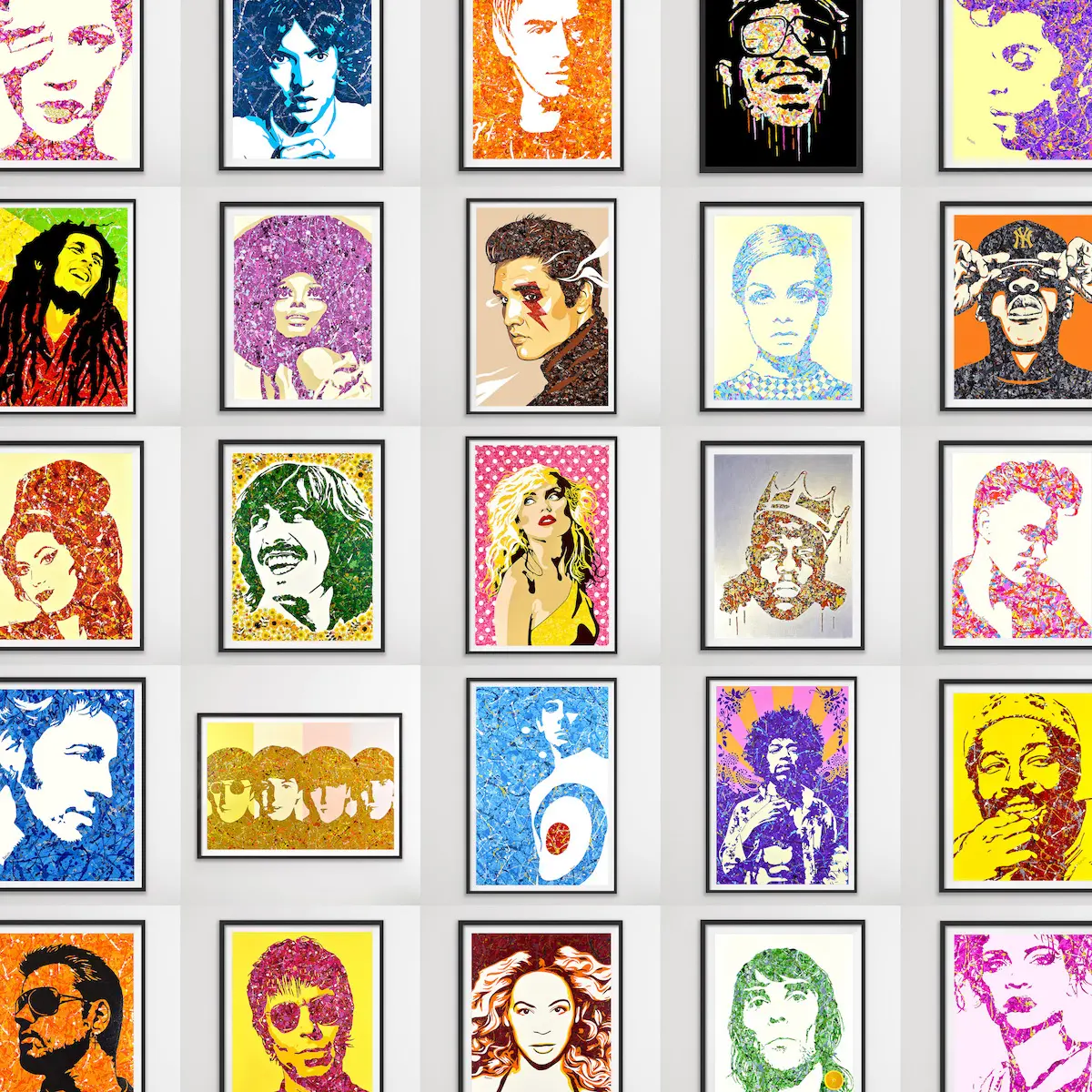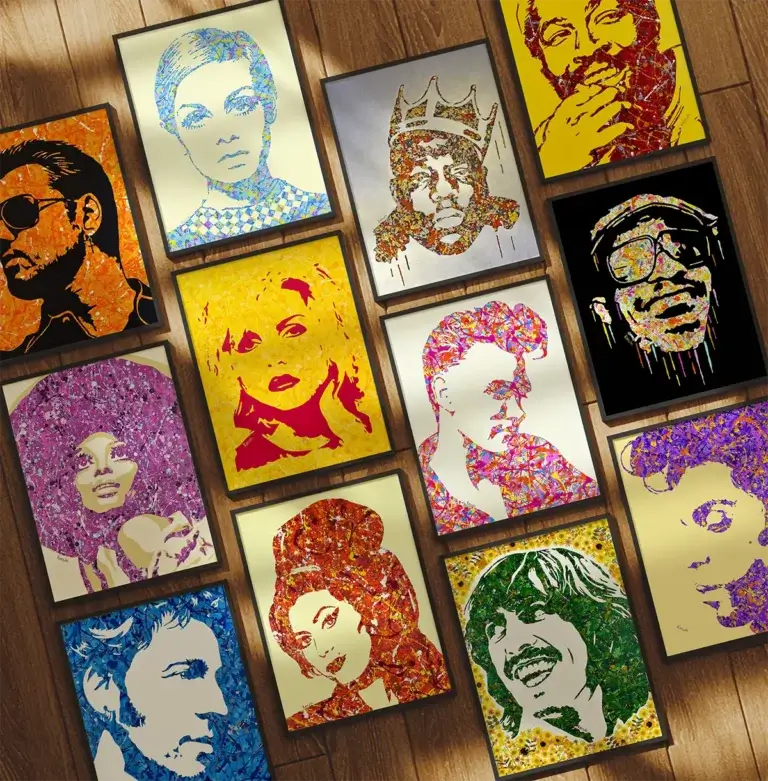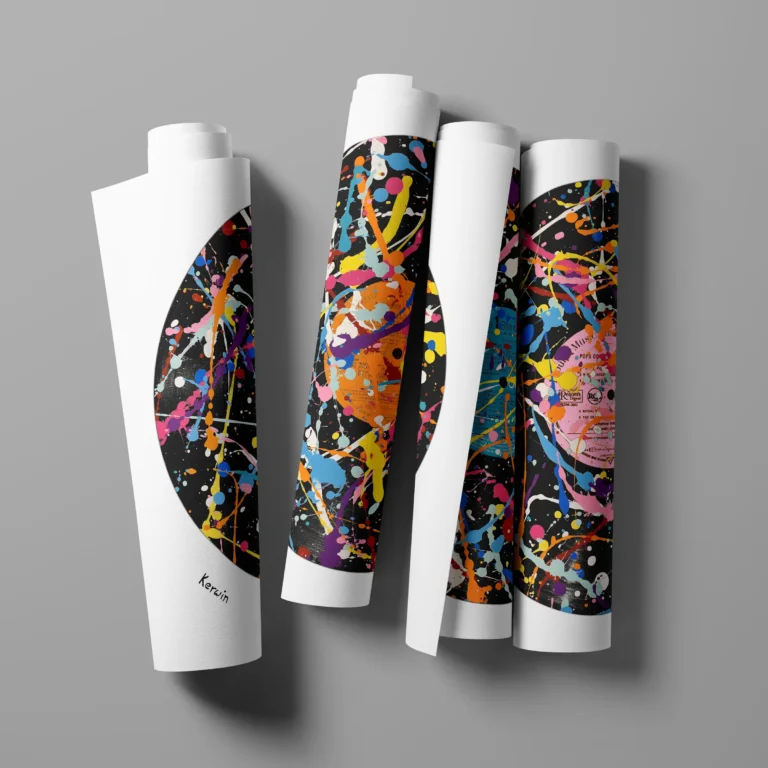In the fascinating realm of art movements, Pop Art stands as an iconic pillar, defined by its audacious visual language and thought-provoking themes. Emerging during the mid-20th century, this avant-garde movement continues to wield a powerful influence on contemporary art and culture.
Pop Art’s unique style features vivid colours, consumerist imagery, playful techniques, repetition, and social critique. Pop Art also fuses high and low-brow art, celebrity spotlight, bold typography, and cultural introspection. It reshaped art and reflected society in a vibrant, accessible manner.
In this exploration, I dive deep into 9 distinct characteristics that define Pop Art, with the aim to shed light on what makes Pop Art so alluring and impactful. Read on to learn more about what makes an artwork ‘Pop Art’.


Born amidst the post-war fervour of the 1950s and 1960s, Pop Art burst forth as a rebellion against tradition, infusing the art world with vibrant energy and audacious concepts.
Through its bold use of colour, play with everyday imagery, and sharp commentary on consumer culture, Pop Art became a bridge connecting the mundane and the extraordinary. Rooted in a spirit of innovation and critique, Pop Art transcended the confines of galleries and museums, sparking conversations among the masses.
This movement, characterised by its embrace of popular culture and daring reinterpretations, mirrored the evolving world it was birthed into. From Roy Lichtenstein’s iconic comic book-inspired canvases to Andy Warhol’s vivid portraits of cultural icons, Pop Art captured the essence of an era defined by mass media, consumerism, and a burgeoning celebrity culture.


Pop Art’s unique style features vivid colours, consumerist imagery, playful techniques, repetition, and social critique. Pop Art also fuses high and low-brow art, celebrity spotlight, bold typography, and cultural introspection. Pop Art reshaped art and reflected society’s complexities and evolution in a vibrant, accessible manner – pushing artistic boundaries in the process.
Pop Art stands out from all other art styles and movements. Nine of the unique, key characteristics and features of the Pop Art style that made it so revolutionary – which continue to inspire audiences worldwide today – are discussed below.
In order to better understand why Pop Art’s 9 unique characteristics are important, it may be helpful to learn about the motivations and inspiration behind the Pop Art movement. Read my blog post on this topic – and learn why Pop Art was so rebellious – here.
Nine unique features of Pop Art are:
The very essence of Pop Art is infused with an electrifying burst of colours that captivate the eye and stir the senses. This vibrant palette isn’t merely a decorative choice; it’s a reflection of the movement’s core values.
Artists such as Roy Lichtenstein, with his meticulous application of primary colours, and Andy Warhol, renowned for his vivid interpretations of cultural icons, embraced colour as a language of emotion and expression.
Lichtenstein’s “Drowning Girl” is a testament to his mastery of colour, employing bold hues to convey complex emotions while paying homage to comic book aesthetics. On the other hand, Warhol’s vibrant renditions of Marilyn Monroe and Campbell’s Soup cans demonstrate his profound understanding of colour’s ability to transcend the canvas and evoke a spectrum of feelings.
Read my blog post on the vibrant colour palettes employed within Pop Art, here.


The emergence of Pop Art coincided with the rise of consumer culture, and artists wholeheartedly embraced this shift in societal dynamics. Commonplace supermarket items and food, from soda cans to soapboxes, were reimagined as subjects worthy of artistic exploration.
Claes Oldenburg’s oversized typewriter eraser and colossal three-way plug are quintessential examples of this transformative approach, challenging the traditional demarcation between art and the everyday.
This celebration of consumerism was more than an aesthetic choice; it was a statement on the ever-blurring line between commercialism and creativity. By elevating items from the supermarket aisle to the gallery wall, artists were questioning the very essence of art’s exclusivity.


The prevalence of repetition and serial imagery within Pop Art reflects the zeitgeist of a world increasingly dominated by mass production and consumerism. This approach, embraced by artists such as Warhol, speaks to the power of imagery’s repetition in shaping collective perceptions.
Warhol’s multiple portraits of Marilyn Monroe are not just depictions; they are commentaries on the way media saturation moulds our understanding of icons.
The act of replicating these images is a deliberate move: every repetition is a nod to the infinite reproductions in the realm of media. In Warhol’s hands, Marilyn becomes more than a movie star; she transforms into a symbol of the duplications that permeate modern society.


Pop Art’s influence stretches beyond aesthetics; it is inherently political and social in nature. The movement’s distinct characteristic of irony and critique of society takes centre stage, as artists use their works to challenge norms, question conventions, and prod at the underbelly of contemporary life.
Richard Hamilton’s “Just what is it that makes today’s homes so different, so appealing?” encapsulates this spirit. By fusing a collage of household objects with a well-built bodybuilder, Hamilton crafts a narrative of consumerism and physical ideals intertwined.
Hamilton’s is a witty commentary that forces viewers to confront the absurdity of their desires and aspirations, inviting them to consider the superficiality that underpins modern society.

The playground of Pop Art is a space of experimentation and innovation. Artists like Lichtenstein paved the way for a new realm of creativity, bringing comic book aesthetics to the forefront. His use of comic-style dots and bold lines, as seen in “Whaam!” (below) and “Oh, Jeff… I Love You, Too… But…”, added a layer of dynamism to his works.
This spirit of playfulness not only injected vigour into the art world but also transcended the canvas into the materials used. Claes Oldenburg’s sculptures, such as the soft typewriter eraser and ice cream (below), showcased his whimsical take on art’s traditional mediums, challenging the notion of what art materials should be.


Central to the essence of Pop Art is its connection to everyday life and popular culture. Artists sought inspiration from the ordinary, turning mundane objects into extraordinary creations.
Warhol’s legendary “Campbell’s Soup Cans” series stripped away the grandiosity often associated with art, turning focus to the commonplace and mundane. His deconstruction of the mundane opened a discourse on value, prompting contemplation on the worth attributed to both art and everyday objects.
Lichtenstein, another icon of the movement, delved into the realm of comic books, using panels and speech bubbles as the foundation for his masterpieces. “Whaam!” transports viewers into a comic strip world, inviting them to engage with the familiar while challenging perceptions of what constitutes fine art.

In the past, the distinction between high and low art was clear-cut, with the former regarded as cultured and the latter as trivial. Pop Art emerged as a disruptor, erasing these conventional boundaries.
By incorporating elements from mass media and popular culture, artists were dismantling the ivory tower of high art, inviting everyday individuals to partake in the conversation.
Richard Hamilton’s collage “Just what is it that makes today’s homes so different, so appealing?” epitomises this blurring of lines. He weaves images from advertisements, comic books, and domestic life into a tapestry of symbolism that’s both accessible and thought-provoking.
This melding of mediums dismantled the barriers of artistic elitism, broadening art’s reach and impact.


Celebrities hold a unique place in modern society, and Pop Art keenly observed this phenomenon. Icons from the realms of film, music, and politics became the subjects of artistic exploration. Warhol, in his portraits of Marilyn Monroe and Elvis Presley, not only captured their visages but also presented a commentary on the cult of celebrity.
These works highlighted the complex interplay between an individual’s public image and their private reality. Warhol’s multicoloured Marilyns, in particular, stand as a tribute to the pop culture goddess while also casting a shadow of contemplation on the price of fame.
My own range of By Kerwin acrylic paintings uses music and pop culture icons as its subject choice. Explore my colourful portraits here!


Words possess a unique potency, and Pop Art harnessed this power by incorporating bold typography and language into its creations. The marriage of textual elements with visual art added layers of meaning, underscoring the movement’s capacity for thought-provoking depth.
Lichtenstein’s “Crying Girl” exemplifies this aspect, blending emotional imagery with textual exclamations. The juxtaposition highlights the interplay between image and language, prompting viewers to explore the intricate relationship between communication and perception.


The tapestry of Pop Art is woven with the threads of colour, consumerism, innovation, and critique. The 9 unique characteristics above intertwine to form a narrative that transcends the canvas and extends into society’s psyche.
As you journey through the world of Pop Art, I invite you to explore my stylish Pop Art paintings of music’s biggest icons on my art website and online shop, www.bykerwin.com. Dive into my dedicated blog section to learn more about the story of Pop Art and how it is such a fun style of art.
You can then grab prints of your favourite paintings of mine to add a splash of colour to your own walls. Who will you choose?
From the bold colour choices that evoke emotions to the witty critiques of consumerism, Pop Art’s impact ripples through time. Its capacity to provoke thought, challenge norms, and engage viewers on multiple levels is a testament to its enduring relevance.
The legacy of Pop Art endures not only in its influence on subsequent generations of artists but also in its ability to spark conversations. As you contemplate the vibrant colours, analyse the critiques, and engage with the playfulness, I hope you discover the beauty of Pop Art’s 9 unique characteristics.
Embrace the movement’s spirit of innovation and reflection, and join me in celebrating the endless world of creativity it continues to inspire!
This captivating journey through Pop Art’s 9 unique characteristics unveils a movement that’s far more than an artistic trend; it’s a cultural phenomenon that reshaped perceptions and norms. The bold use of colour, incorporation of consumer culture, embrace of repetition, irony’s sharp wit, playful techniques, and blurring of artistic boundaries all contribute to Pop Art’s mesmerising allure.
Moreover, the movement’s engagement with everyday imagery, exploration of celebrity culture, and integration of bold typography further solidify its profound impact.
In this exploration, we’ve embarked on a visual and intellectual expedition through the world of Pop Art. Its pulse continues to beat strong as contemporary artists reinterpret its essence for the modern age (such as with my own Jackson Pollock-style action painting Pop Art portraits).
As you reflect on the 9 unique characteristics that define this movement, I invite you to explore my art website and online shop. Here, you can view and shop my full range of stylish Pop Art portrait paintings and prints of music’s biggest icons through the eras.
The journey through Pop Art is not merely an exploration of artistic innovation; it’s an immersion into a movement that transcends mediums, challenges perceptions, and evokes emotions. Join me as I celebrate the dynamic spirit of Pop Art and its timeless impact on the canvas of art history.

What is your favourite feature of the Pop Art style? Explore my range of hand-painted acrylic Pop Art music icon paintings – and shop prints of your favourites – here
Discover my full blog section on Pop Art here.


View my full range of Jackson Pollock-inspired pop art paintings and prints of your favourite music and pop culture icons at www.bykerwin.com. High-definition printing, fast worldwide delivery and satisfaction guaranteed. You can follow my art progress on Instagram and Facebook.


